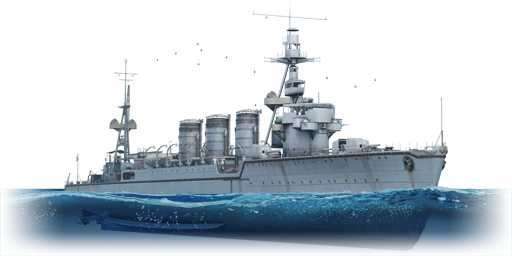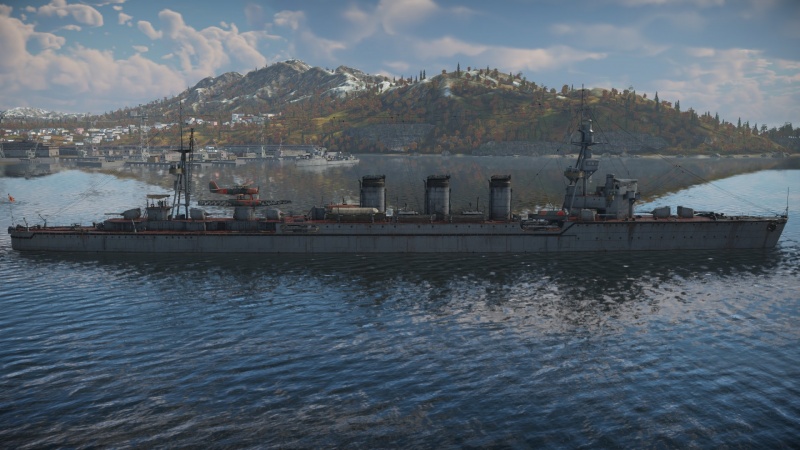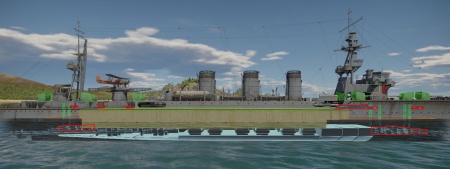IJN Tama
Contents
Description
The Kuma-class, IJN Tama, 1942 (球磨, namesake: Kuma River) is a rank III Japanese light cruiser with a battle rating of 5.0 (AB/RB/SB). It was introduced in Update 1.89 "Imperial Navy".
General info
Survivability and armour
The IJN Kuma is the weakest light cruiser when it comes to taking enemy fire, being unable to repel anything but destroyers in a direct, short-range gun battle. On top of having the lowest crew complement among cruisers, it suffers from one major weakness: ammunition explosions.
Both: First-stage ammo stowage and its main ammunition storage (Charge/Shell/Ammunition storage rooms) are exposed to direct enemy fire. The main storage is somewhat protected by the 44.6 mm plate above it, however, it's above the waterline, allowing for lucky shells to get unimpaired into one of the rooms and blow it up. If the crew did not suffer particularly many casualties beforehand - ship can survive, however, such a blow is extremely severe, turning what otherwise would be a fresh ship, into a burning husk rapidly taking water in.
Moreover: The citadel armour is the weakest among cruisers, amounting to only 63 mm RHA. While on paper Emden, 1944 has only 50 mm, it's just for an internal plate, with a second 50 mm plate in front of it. Under battle conditions this gives her much better protection, in particular at a point-blank range, where she's completely immune to Kuma's 140 mm type 2 SAP shells. Kuma's citadel armour is enough to deflect only secondary armament (such as 3-inch Mark 10), HE shells from the main guns or certain low-penetration AP shells at a high angle of attack (such as 180 mm/60 B-1-K's PB-32 SAPCBC shell at angles of over 72°, or Kuma's own 140 mm type 2 SAP shells at any angle).
Mobility
| Mobility Characteristics | |||||
|---|---|---|---|---|---|
| Game Mode | Upgrade Status | Maximum Speed (km/h) | Turn Time (s) | Turn Radius (m) | |
| Forward | Reverse | ||||
| AB | Stock | 52 | 22 | ~217.87 | ~356.38 |
| Upgraded | 71 | 29 | ~101.47 | ~210.83 | |
| RB/SB | Stock | 52 | 22 | ~249.2 | ~407.63 |
| Upgraded | 62 | 25 | ~173.8 | ~330.4 | |
Modifications and economy
As with every cruiser, the FPE and Tools are the most important modifications. Following that the goal is to reach the Ammo Wetting and 140 mm mod 1 SAP shells as soon as possible. Rudder Replacement would be a wise choice for the 3rd modification to unlock, as it increases your chances of dodging torpedoes, bombs, or perhaps even incoming shells if spotted early enough. In tier III the 140 mm mod 1 SAP and then Ventilation should be prioritized to increase firing power and decrease the crew loss in an event of a fire. The final required modification for the tier should typically be the Propeller Replacement, as it offers a significant improvement in mobility. Finally, for the tier IV you unlock Ammo Wetting, then Torpedo Mode. From now there's more freedom of choice. Two primary paths include the rest of Seakeeping or unlocking the Targeting modifications to help with the roll issues of the main guns. The least important modification is the Bomb mortar, as using depth charges on a cruiser is a grossly misguided venture.
Armament
Primary armament
Kuma has above-average sustained firepower for its BR when firing a broadside of 6 guns from the first-stage ammo stowage, even despite ship's individual guns being sub-pair when compared with an armament of the ships in the same BR. As a consequence she as the worst firepower directly in the rear and ahead. Especially given an extremely narrow-angle where 3 turrets firing ahead can simultaneously shoot at the same target, while at the rear she's covered by just a single 140 mm gun.
Guns have an acceptable reload speed and the second-best turning speed in its BR, though they suffer from one of the worst shell velocities among counterparts. Good horizontal guidance of the turrets allows her to fire most of its guns at a relatively steep angle of approach, minimizing exposed silhouette. That said though, once receiving all mobility upgrades, the ship will have an issue with roll exceeding negative vertical guidance of the turrets during the turns at high speed, making it impossible to engage targets at any range, often for significantly more than the full gun reload time.
Four types of ammunition are available, with HE shells being the only one open without any modifications unlocked:
- type 0 HE - Primary type of shell, useful against all targets at all ranges. It's relatively good in fighting enemy ships of all types, primarily thanks to its good chance of igniting enemies. When fighting heavy cruisers with HE, shells should be fired at the superstructure whenever possible to prevent shells from being nullified by the armour.
- type 0 HE-DF - Time-fuzed anti-aircraft shells. Their usability is highly situational due to the vertical guidance of just +20° that prevents effective engagement of anything but torpedo bombers.
- type 2 SAP - tier 1 modification, it offers a larger explosive payload comparing to the type 1, though its penetration is usually insufficient to engage armoured parts of enemy cruisers at anything but the point-blank range. It's useful primarily against unarmoured targets, such as most of destroyers.
- type 1 SAPBC - anti-cruiser semi-armour piercing shells, with increased penetration for the price of explosive payload. Though even with that increase, it will still struggle against heavy cruisers, or even citadels of a certain light cruisers at range. Still, though, it is typically the primary shell type to be used against heavier enemy warships.
Secondary armament
Dual-mount secondary 25 mm guns are positioned on sides of the first funnel. They have relatively good firing arcs, both: horizontal and vertical, although rarely able to bring both emplacements firing at a target at the same time. Realistically speaking those are the primary anti-aircraft armament of the ship.
That said though - they are still an exceptionally poor anti-aircraft weaponry, the worst among cruisers of all nations, being able to take down only the least cautious enemy airplanes. Similarly, when faced with enemy boats - using primary armament to take them down is always a vastly superior solution, even when manually controlling the guns.
Anti-aircraft armament
Next to the bridge superstructure there are located two 7.7 mm machine guns. They play a support role against hostiles below 1 km range, that said though: Within its BR those guns provide an insignificant amount of firepower, being nothing more than a nuance to the enemy.
Additional armament
The Kuma comes with an unusual type of torpedoes for a Japanese warship. Its wet-heater Type 6 torpedoes are the worst torpedoes one can find one a Japanese Capital Ship, featuring low damage potential, slow speed, and a relatively short range (although that gets alleviated by the Torpedo Mode). The notable upside of the ship is the fact that she carries a full reload of torpedoes, allowing for surprise attacks and exploiting opportunities more than once during the battle.
Stock
When stock, with just 7 km range at the speed of 65 km/h, the usefulness of torpedoes is limited pretty much only to short-range counter-torpedo activities, or late-match encounters. That said though, ideally, torpedoes would be used only as a defensive measure, dropped between main gun salvoes or during the turns, as typically hostile ships will have ample time to avoid while themselves having faster and more potent torpedoes.
Torpedo Modification
Once equipped with a torpedo modification it increases range to 15 km at the price of decreasing speed all the way down to 48 km/h. Use cases extend to an area-denial, taking down less aware cruisers or AI-controlled units, notably Cargo ships. The very slow speed, however, is a significant challenge, as sometimes you'll find even cruisers easily avoiding hits, with the barest adjustments of course making it impossible to score hit by the time torpedo actually arrives at the target location. Hitting a destroyer with torpedoes after the modification boils down mostly to luck or failure of the enemy captain to first change the course and then spot an obvious, slow-moving trails. Typically a wider cone of torpedo spread might be preferable for increasing a hit chance when dropping them against the larger number of enemy ships. Trying to nail a lone warship at a long range is a moot effort.
Scout plane
Located amidships is a catapult with one E7K2 scout plane which provides unique offensive and defensive abilities, expanding tactical options. Ship-launched scout planes fly just like regular tree units but lack munition choices and cockpit views. The E7K2 is equipped with only defensive machine gun turrets (ventral as well as dorsal) but it does carry 4 x 60 kg bombs. It also has the scout plane ability to cap zones and lay down smoke cover (up to 3 times). Captains will be wise to remember to utilize the aircraft and consider when best to use it, for example to cap a point early or late in the match, to create a smoke screen to stymie enemy bombardment and repair, to attack enemy units directly, or perhaps something completely new! Carrying a heavier bomb load than most other scout planes, this unit has a very good chance to sink enemy boats or even a destroyer.
Usage in battles
IJN Kuma is a relatively weak cruiser, requiring more skill to play than the majority of its counterparts. It's not exceptional in any dimension while having two important downsides: exposed ammunition storage and negligible anti-aircraft armament. Even a typical upside of the Japanese warships - torpedoes - is crippled due to Kuma featuring the worst torpedoes one could find in Japan. Torpedo mode mitigates the issue somewhat, but if one wants to play torpedo-centric gameplay, any Japanese destroyer would be a better choice.
The best strategy is to be a strong team player. Use vastly superior anti-aircraft armament of the friendly warships to provide you with an anti-aircraft cover, pick equal or weaker targets with your guns, use your torpedoes on larger groups of enemies or AI targets. If playing arcade, you should drop torpedoes frequently, and if it's not convenient to make a 180° turn to attack with the other side (e.g. because you'd break the formation), just drop them into the water without any target, and wait for an automatic reload. Kuma's main speed is higher than the one of other ships, so you can perform evasive action while keeping decently close to a group of friendlies. When concentrated by multiple enemy ships, you should attempt to break contact and flee, or at least put 1 friendly between you and them.
Pros and cons
Pros:
- Above-average firepower for the main calibre broadside
- Able to reload torpedoes in battle
- Good maximum speed for the BR
- Very long-range torpedoes (although relatively slow)
- One scout plane.
Cons:
- Exposed ammunition storage often leads to the ammunition explosions
- Poor AA armament
- Poor forward and rear-facing weaponry compared to the counterparts
- SAP shells offer a very poor penetration and a relatively low explosive filler
History
Kuma (球磨) was laid down in August 1918 in Sasebo Navy Yard on the southernmost Japanese main island, Kyushu. She was completed in 10 months and launched in July 1919. She did not see any action during the interwar period, being kept out of the Second Sino-Japanese War. In 1929 she had rainwater protection devices added to the top of her funnels, making them characteristically bulbous (this missing is but one of several issues with the in-game model of Kuma which most closely reminds a 1942 refit of her sister ship, Tama (多摩)).
Her first combat action was Operation M (M作戦), invasion of the Philippines, where she faced her first fight, being attacked by US airplanes (Catalinas and B-17s) while covering the landings in the northern part of the Philippines. She proceeded further south assisting invasion forces, where she fired her guns at the Cebu harbor, sinking coastal trading vessels. Following that she was ordered to secure the city of Zamboanga, where Kuma assisted with amphibious landings, shelled armed resistance on land and, in the evening of 3 March 1942, has sunk 12 ships in the Sulu Sea, marking it the most successful day in the ship's history. During the night of 8 April 1942 she was attacked by two US torpedo boats (Elco 77 ft) while escorting an invasion force. She suffered a direct hit from an Mk. 8 torpedo in the bow, though it failed to detonate saving the ship. She continued her role as a cover of further landings, ending with the battle of Corregidor Island on 6 May 1942.
In June 1943 Kuma was sent to guard the port of Makassar, where she survived a raid of seventeen B-24 bombers, suffering only minor damage from near-misses.
In November 1943 the ship underwent a significant refit of the armament. Dry-docked in Singapore, her catapult and the turret number 5 ahead of the catapult were removed, instead, two triple-mount 25 mm anti-aircraft cannons were installed on top of the two dual-mount 25 mm in the front.
Early morning of 11 January 1944, during the naval exercises at the Malacca Strait, a lookout on Kuma spotted a periscope-like object. Called in Fubuki-class destroyer Uranami identified it as a false periscope, presuming it to be released by one of the friendly submarines (Japanese used floating devices made of wood and bamboo to lure US aircraft into wasting bombs). This periscope, however, belonged to the British submarine HMS Tally-Ho that at 11:43 fired a spread of 7 torpedoes, Kuma spotted them and attempted evasive action, however, it suffered a hit with two torpedoes to the stern, tearing off a large part of it and igniting fires across decks. Seven minutes into the action depth charges detonated on the quarterdeck. Captain called to abandon ship and within the following seven minutes Kuma has sunk, stern-first, with 138 lives lost. Survivors were rescued by the Uranami, including the captain.
She rested on her starboard, 46 m underwater, with her stern missing all the way to the port propeller. She met an unusually sad fate, being looted for scrap with a use of floating cranes. In 2014 it was reported that looters have cleared up nearly the entire wreck, metal likely being sold to China at the price of roughly 600 Malaysian Ringgit per tonne (125 € / $140 / ¥15,000). Large pieces of Kuma's wreck were photographed in May 2014, later that month Malaysian Marine Department managed to capture the group responsible for the lootings.
Devblog
Due to the expectation that the Tenryū-class cruiser wouldn't perform to the satisfaction of the naval command in its role of leader and the appearance of newer and faster destroyer types, with which the Tenryū wasn't able to keep up with, the shortcomings of the Japanese small cruiser concept became evident. These shortcomings were further emphasized with the advent of the large American Omaha-class light cruiser, capable of easily outgunning the Tenryū-class.
In response to this, Japanese shipbuilders revised Tenryū's design and developed a new, larger version of the ship with increased speed, range and firepower. This new successor design would become known as the Kuma-class light cruiser. With the design being accepted, outstanding plans for the construction of the four remaining Tenryū-class light cruisers, as well as three other cruisers, were cancelled, while an order to construct five Kuma-class light cruisers was issued instead.
Kuma, the lead ship of her class, was laid down in August 1918, launched in July 1919 and subsequently entered service with the IJN the following year, in August of 1920. Immediately after her commissioning, Kuma was deployed as part of the Japanese intervention in Siberia against Bolshevik forces.
During the early 1930s, Kuma underwent a significant refit and later took part in hostilities during the Second Sino-Japanese War, patrolling off the coast of China and assisting in landing operations.
Following the attack on Pearl Harbor, Kuma participated in the Invasion of the Philippines and would remain stationed there until August 1942. After a brief refit in September, Kuma joined the Dutch East Indies and New Guinea campaigns, being tasked with transporting troops and patrolling the local waters until late 1943.
In January 1944, Kuma came under torpedo attack from the British submarine HMS Tally-Ho, shortly after departing Penang. Kuma suffered two hits, with the resulting damage and subsequent depth charge detonations sealing the ship's fate. Kuma was later struck from navy records in March 1944.
Media
- Skins
See also
Links to articles on the War Thunder Wiki that you think will be useful for the reader, for example:
- reference to the series of the ship;
- links to approximate analogues of other nations and research trees.
External links
| Sasebo Naval Arsenal (佐世保海軍工廠) | |
|---|---|
| Destroyers | |
| Mutsuki-class | IJN Mutsuki |
| Hatsuharu-class | IJN Hatsuharu |
| Shiratsuyu-class | IJN Yuudachi |
| Light Cruisers | |
| Agano-class | IJN Agano |
| Unique Ships | IJN Yubari |
| Tanks | Chi-Ha Short Gun |
| Japan light cruisers | |
|---|---|
| Kuma-class | IJN Tama |
| IJN Yubari* | |
| Nagara-class | IJN Isuzu |
| Sendai-class | IJN Sendai |
| Agano-class | IJN Agano |
| Mogami-class | IJN Mikuma · IJN Suzuya |
| * Unique ship | |






